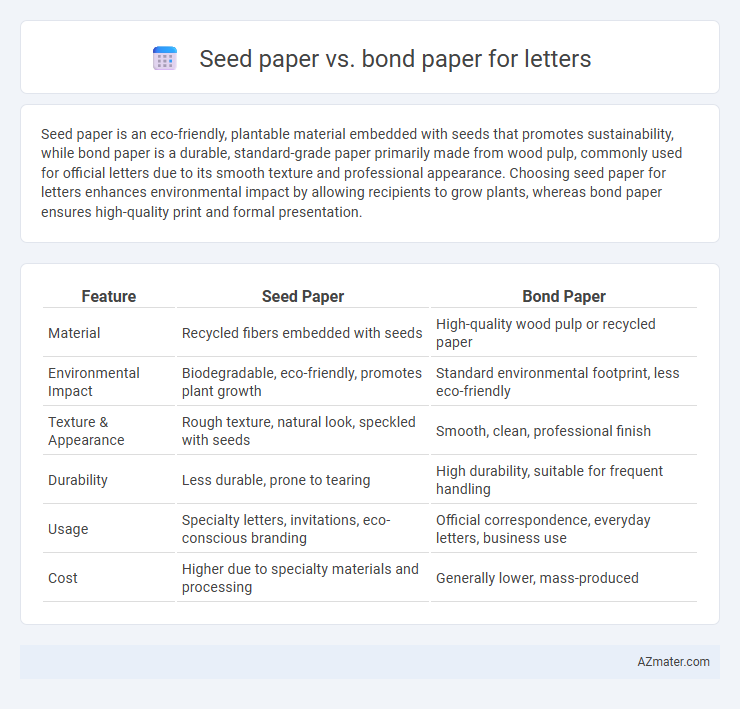Seed paper is an eco-friendly, plantable material embedded with seeds that promotes sustainability, while bond paper is a durable, standard-grade paper primarily made from wood pulp, commonly used for official letters due to its smooth texture and professional appearance. Choosing seed paper for letters enhances environmental impact by allowing recipients to grow plants, whereas bond paper ensures high-quality print and formal presentation.
Table of Comparison
| Feature | Seed Paper | Bond Paper |
|---|---|---|
| Material | Recycled fibers embedded with seeds | High-quality wood pulp or recycled paper |
| Environmental Impact | Biodegradable, eco-friendly, promotes plant growth | Standard environmental footprint, less eco-friendly |
| Texture & Appearance | Rough texture, natural look, speckled with seeds | Smooth, clean, professional finish |
| Durability | Less durable, prone to tearing | High durability, suitable for frequent handling |
| Usage | Specialty letters, invitations, eco-conscious branding | Official correspondence, everyday letters, business use |
| Cost | Higher due to specialty materials and processing | Generally lower, mass-produced |
Introduction to Seed Paper and Bond Paper
Seed paper is an eco-friendly material embedded with seeds that can be planted after use, promoting sustainability and reducing waste. Bond paper, commonly used for official documents and letters, is a durable, high-quality paper known for its smooth finish and strength. Both papers serve distinct purposes, with seed paper emphasizing environmental benefits and bond paper prioritizing professionalism and clarity.
Defining Seed Paper: Composition and Uses
Seed paper is an eco-friendly material embedded with seeds, primarily composed of recycled fibers like cotton or hemp blended with natural seeds such as wildflowers or herbs, designed to be planted after use. It serves dual purposes: functioning as conventional paper for writing letters while promoting sustainability by allowing recipients to grow plants directly from the paper. This innovative composition supports environmental conservation efforts and adds a unique, interactive element to letter correspondence compared to traditional bond paper.
What is Bond Paper? Features and Applications
Bond paper is a high-quality, durable writing paper commonly used for letterhead, official documents, and business correspondence due to its strength and smooth texture. It typically has a weight ranging from 16 to 24 pounds, providing a professional appearance and excellent printability for ink and toner. Widely used in offices and print shops, bond paper supports photocopying, laser printing, and handwritten communication, making it ideal for contracts, resumes, and formal letters.
Environmental Impact: Seed Paper vs Bond Paper
Seed paper is eco-friendly, made from recycled materials embedded with plant seeds that decompose and grow when planted, significantly reducing waste and landfill impact. Bond paper, typically produced from virgin wood pulp, involves higher energy consumption and deforestation, contributing to a larger carbon footprint. Choosing seed paper for letters promotes sustainability by combining functionality with environmental regeneration, unlike traditional bond paper which is less biodegradable and more resource-intensive.
Sustainability and Biodegradability Comparison
Seed paper, embedded with plant seeds, offers a highly sustainable and biodegradable alternative to traditional bond paper, enabling planting after use and reducing environmental waste. Bond paper, primarily composed of wood pulp and often treated with chemicals, lacks biodegradability and sustainability, contributing to deforestation and longer decomposition periods. Choosing seed paper for letters enhances eco-friendly practices by promoting soil enrichment and minimizing landfill accumulation compared to conventional bond paper.
Print Quality: Seed Paper vs Bond Paper
Seed paper offers a unique textured surface that may slightly affect print clarity compared to the smooth finish of bond paper, which provides sharp and consistent print quality ideal for professional letters. Bond paper's uniform weight and texture ensure ink adherence without bleeding or smudging, making it preferable for high-resolution text and graphics. In contrast, seed paper's natural fibers and embedded seeds can cause uneven ink absorption, resulting in a more organic but less precise print appearance.
Cost Analysis: Seed Paper and Bond Paper Pricing
Seed paper typically costs between $0.50 to $1.50 per sheet, reflecting its eco-friendly composition and embedded seeds, making it a premium option for letters. Bond paper pricing ranges from $0.01 to $0.10 per sheet, offering an economical choice for mass mailing or standard office use. The higher price of seed paper is justified by its sustainable benefits and unique planting potential, whereas bond paper excels in affordability and wide availability.
Usability for Letters and Official Correspondence
Seed paper offers an eco-friendly option for letters by embedding plantable seeds within the paper fibers, making it ideal for businesses emphasizing sustainability in official correspondence. Bond paper remains the preferred choice for formal letters due to its smooth texture, durability, and consistent print quality, ensuring professional presentation and legibility. For official correspondence, bond paper's reliability in ink absorption and crispness outweighs seed paper's environmental benefits when clarity and formality are paramount.
User Experience and Reception
Seed paper offers a unique user experience by combining eco-friendliness with tactile engagement, as recipients can plant the paper to grow flowers or herbs, enhancing emotional connection and memorability. Bond paper provides a smooth, professional surface ideal for clear printing and formal correspondence, ensuring legibility and traditional business reception. Recipients often perceive seed paper letters as thoughtful and innovative, while bond paper letters are valued for their reliability and conventional professionalism.
Choosing the Right Paper for Your Letters
Choosing the right paper for your letters depends on purpose and impact; seed paper offers eco-friendly, plantable qualities that enhance sustainability and leave a memorable impression. Bond paper provides durability, smooth texture, and professional appearance ideal for formal correspondence and everyday use. Consider seed paper for unique, environmentally conscious messages and bond paper for traditional, reliable communication.

Infographic: Seed paper vs Bond paper for Letter
 azmater.com
azmater.com